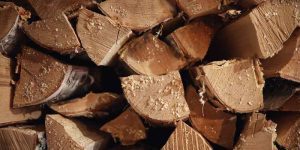Burning black walnut wood is not toxic, but the wood contains a chemical called juglone that can be harmful to other plants. When burned, the heat breaks down the juglone, so burning black walnut in a fireplace is safe to do.
It is a good source of firewood and much better than softer woods like pine. We will discuss burning black walnut wood in detail and answer questions related to its toxicity and safety. We will also look at the benefits of using black walnut wood in your fireplace and compare it with other types of wood that should not be burned.
Whether you are a regular fireplace user or someone just starting out, this article will be a valuable resource for anyone wanting to know more about burning black walnut wood.
The Toxins In Black Walnut Wood
Black walnut wood contains a toxin called juglone, produced by the extractive prejuglone, which can oxidize and become highly toxic to humans at certain doses. However, it is safe to burn black walnut wood in a fireplace, as the chemicals break down in the fire and the resulting ash is not harmful.
What Makes Black Walnut Wood Toxic?
Black walnut trees are unique in that they contain natural chemicals that are toxic to many other plants. This is because the tree produces an extractive called prejuglone, which oxidizes into juglone on contact with air. Juglone can cause damage to the root systems of neighboring plants, leading to them withering and dying. However, it’s not just other plants that black walnut wood can be harmful to. Burning black walnut wood releases the toxin juglone into the air, increasing the risk of toxicity for those in the vicinity.
Dangers Of Inhaling Black Walnut Smoke
Inhaling smoke from burning black walnut wood can be dangerous to human health. The toxic fumes released by the wood can cause respiratory problems, including shortness of breath, coughing, and wheezing. Prolonged exposure to these fumes can lead to more serious conditions like asthma, bronchitis, and other lung diseases. It is crucial to avoid inhaling black walnut smoke, whether in a residential fireplace, wood stove, or outdoor fire pit.
Can The Ash From Black Walnut Wood Be Harmful?
Although burning black walnut wood can release toxic fumes, the ash it produces is generally safe to handle and dispose of. In fact, like most hardwoods, black walnut wood ash can be used as a natural fertilizer for plants and garden soil. However, it’s essential to wear gloves when handling the ashes to avoid skin irritation, as the alkaline nature of the ash can cause dryness and redness. Moreover, one should avoid handling or disposing of the ashes in wind-prone areas, as exposure to airborne particles can cause respiratory problems.
Effects Of Burning Black Walnut Wood
Black walnut wood contains a chemical called juglone that can be toxic to humans and other plants. However, when burned in a fireplace, the chemicals break down and the resulting ash is not harmful. Therefore, it is safe to burn black walnut wood in a fireplace.
Can You Burn Black Walnut Wood For Firewood?
If you are wondering whether burning black walnut wood is safe for your fireplace, the quick answer is yes. Black walnut wood is great for firewood as it burns well, producing a lot of heat and lasting through the night. Unlike softwoods such as pine, black walnut wood does not give off much smoke, making it a great option for your fireplace. However, before you go ahead and burn black walnut wood, it is crucial to know more about its effects on your health and the environment.
How Does The Burning Affect Juglone?
Black walnut produces an extractive called prejuglone, which oxidizes into juglone on contact with air. Juglone is responsible for the beautiful brown color of walnut wood and also acts as a potent herbicide. When burned, the wood releases juglone into the air, which can cause skin and respiratory irritations in humans. However, it is crucial to note that burning black walnut wood will not pose a significant threat to your health as the amount of juglone released is usually small.
What Are The Effects Of Long-term Exposure To Juglone?
Exposure to juglone over an extended period can lead to more severe health problems. The chemical is highly toxic, and at sufficient doses, it can cause liver damage and even cancer. Therefore, it is crucial to limit your exposure to wood smoke and ensure your fireplace or wood stove is well-vented. Additionally, if you work with black walnut wood and produce sawdust, it is essential to wear a mask and avoid inhaling the dust as it can be harmful.
In conclusion, while burning black walnut wood is generally safe for your fireplace, it is crucial to limit your exposure to the smoke. It is also essential to wear protective gear when working with black walnut wood and its byproducts such as sawdust. Finally, ensure proper ventilation in your fireplace or wood stove to minimize the effects of wood smoke on your health.
Alternatives To Burning Black Walnut Wood
Black walnut wood contains juglone, an extractive that can oxidize into a potent herbicide and is highly toxic to humans. If you’re concerned about burning black walnut wood due to its toxicity, there are other safe alternatives available such as ash, oak, maple, and cherrywood.
These hardwoods produce a lot of heat, last longer, and do not give off much smoke making them better for firewood than softwoods like pine.
What Other Types Of Wood Are Toxic To Burn?
While burning hardwoods like oak, cherry, maple, and walnut is generally considered safe, there are a few types of wood that can be toxic if burned. Softwoods like pine, fir, and cedar can produce excessive smoke and creosote buildup, which can lead to chimney fires. Treated or painted wood should also never be burned as they can release harmful chemicals like lead and arsenic. Additionally, wood from fruit trees like apple, pear, and cherry should not be burned as they contain high levels of resin, which can create a thick layer of creosote in the chimney.
What Is The Best Type Of Wood To Burn In A Fireplace?
While all hardwoods make for great firewood, some types are better than others. Oak, maple, and hickory are popular choices as they are dense and burn hot and long. Cherry and ash are also great options as they produce a pleasant aroma when burned. Ultimately, the best type of wood to burn depends on personal preference and availability in your area.
Are There Any Safe Uses For Black Walnut Wood Other Than Burning?
While black walnut wood should not be burned due to the potential toxicity of the chemicals it contains, there are other safe uses for it. The wood can be used for furniture making, flooring, and even as a cutting board material. The nuts themselves are also a tasty and nutritious snack. Before using black walnut wood for any purpose, it is important to research the specific safety concerns and take necessary precautions such as wearing gloves and a mask while sawing.

Frequently Asked Questions On Is Burning Black Walnut Wood Toxic
Is It Safe To Burn Black Walnut In A Fireplace?
Yes, it is safe to burn black walnut wood in a fireplace. All hardwoods are great for burning because they provide a lot of heat, last through the night, and produce little smoke compared to softwoods. While black walnut wood does contain the toxin juglone, it breaks down in the fire and the resulting smoke and ash are no more toxic than any other wood.
Is Black Walnut Wood Toxic To Humans?
Yes, black walnut wood can be toxic to humans. It produces a chemical called juglone, which is highly toxic and a potent herbicide. However, the chemicals break down as the wood burns, so the ash isn’t as harmful as the sawdust.
Therefore, it is safe to burn black walnut in a fireplace.
What Kind Of Wood Should Not Be Burned In A Fireplace?
It is safe to burn all hardwoods in a fireplace, including black walnut wood. However, black walnut wood contains a chemical called juglone, which can be toxic to humans and other plants at a certain dose. The good news is that as the wood burns, the juglone breaks down so that the ash is not as harmful as the sawdust.
How Long Does Black Walnut Firewood Take To Dry?
Black walnut firewood takes approximately 1-2 years to dry, depending on the thickness of the logs and the drying conditions. It is recommended to split the wood into smaller pieces and store it in a dry, well-ventilated area to speed up the drying process.
When fully dry, black walnut firewood burns hot and long, making it an excellent option for fireplaces and wood stoves.
Conclusion
While black walnut wood does contain the toxic chemical juglone, it is safe to burn in a fireplace. The chemicals in the wood break down in the fire, and the resulting ash is not as harmful as the sawdust. As with any firewood, it is also important to ensure proper handling and burning practices to avoid any potential hazards.
Therefore, you can enjoy the warmth and beauty of burning black walnut wood without any worries.


